GMS Field Trip
If you have any questions about field trips send email to
Fossil Tracks
GMS/DMC Field Trip
Trace Fossil Site in Alabama
Saturday, May 17, 2014
A heartfelt thank you to Ashley Allen, Prescott Atkinson, Milo Washington and all of our new friends at the Alabama Paleontological Society! Several APS members were on hand to help field trip participants find and identify fossils. They even found and offered specimens to others as they uncovered them! GMS members helped make this DMC trip special too. Casey Sosebee loaned his tent. Jim Haege and Marzi helped purchase goodies and helped set up the hospitality area. Bonney Weathers hauled stacks of buckets that were available for participants to take home. The buckets were donated by a Roswell, GA soil analysis lab. Charles and I donated extra field notebooks with matching pens that I purchased for last year’s sand conference plus some left over from the conference itself, so DMC participants could take home an extra little gift. Many people came together to make this trip memorable.
The cold, wet, windy morning made this a memorable trip too. APS vice president Prescott Atkinson greeted assembling participants until the sky opened up and sent all of us scrambling for our vehicles. As we sheltered from the rain, Marzi and I eagerly perused a magnificent book about Alabama geology and paleontology called “Lost Worlds in Alabama Rocks: A Guide to the State’s Ancient Life and Landscapes” by Jim Lacefield. I had just purchased it from a few copies that the APS members brought along and had only a few seconds to protect it from the rain before we jumped into the car. It wasn’t long before the drenching rain slowed to a dribble and rockhounds re-emerged. By the time Prescott began an informative description of the site as it was 300 million years ago, the rain was just a mist. Prescott held up a map of the area that shows where the mine was located during the time Pangea was still forming. He explained how harsh acidic conditions prevented fossilization of animal remains, but gentle tidal conditions were perfect for depositing layers of silt that helped preserve tracks and other traces. APS members brought field trip guidebooks filled with images of the trace fossils that can be found in the mine. A pdf of the guidebook is available on the APS website as well. It is an excellent resource for identifying specimens and is absolutely awesome to look through.
Originally a coal mine, the site is now designated as a protected fossil track site. It was officially preserved in 2004 through the combined efforts of the members of the APS, professional paleontologists from the Geological Survey of Alabama, and others from around the world. The APS continues to sponsor an ongoing project to document, study, and preserve the site and the fossils it yields. In 1999, a high school student brought the mine to the attention of Ashley Allen, who was the student’s science teacher at the time and is currently the president of the APS. Ashley visited the site and quickly realized the importance of the fossils there. He reported the information to other APS members who alerted professional paleontologists. Because mining had ceased at the site it was in imminent danger of reclamation. Geologist and amateur paleontologist Steven Minkin helped lead preservation efforts. It has since been described as the most prolific source of vertebrate trackways of its age in the world.
About 28 vehicles (more than 60 people representing about 9 different clubs) caravanned to the site and parked along the road in an amazingly efficient vehicular ballet. Before I popped out of the car, people were climbing up and over rocks and splitting open shale. The old mine readily relinquished beautiful specimens. Among the finds were trilobite tracks and resting traces, perfectly preserved plant fossils, invertebrate and vertebrate tracks, various burrows, fish fin and tail swirls, swamp gas bubbles, and raindrops!
The site had long furrows of shale and sandstone that were easy to work. Some people split shale while others simply picked up and turned over already broken shale. Sandstone chunks with trilobite traces were peppered all over the site. APS members graciously answered questions and identified fossils for everyone as they walked around the site. Some APS members broke open shale and offered samples of fossils to anyone who wanted some or just wanted to see what they looked like. Everyone I talked to as I walked around the site had specimens to show me. Everywhere I turned someone was turning up something interesting.
GMS member Monica Scheller uncovered an unusual lycopod fossil that intrigued the APS members. She donated the specimen to the McWane Science Center in Birmingham, AL so it could be studied and identified. It has been described as a “spectacular specimen” and it may be used by the Smithsonian Institution for a paper they are preparing on some Lower Pennsylvanian lycopods! It was incredibly thrilling to be there to see a remarkable discovery like this – congratulations Monica!
When I stopped briefly to enjoy the mild weather and the aroma of nearby honeysuckle blossoms, it struck me how fortunate we are to have such a wonderful collecting opportunity. Where else could you see and collect fossils like this? And how often is a site like this discovered and saved? The APS and the state of Alabama have done a fantastic job keeping this site maintained and available for amateur collectors as well as preserving an incredible collection of fossils that offer a paleontological glimpse into the lives of some creatures who simply walked across some wet ground.
Despite the cold, wet, dreary conditions under which the trip began, it ended with comfortable collecting weather, fascinating fossils that the morning rain conveniently pre-washed for us, and a lot of lucky, happy rockhounds.
Lori Carter, on behalf of
Charles Carter, GMS Field Trip Chair
e-mail:
Photo by Lori Carter

APS vice president Prescott Atkinson describing the site as it was 300 million years ago
Photo by Lori Carter

Buckets donated by Excel Geotechnical Testing, Inc. in Roswell, GA
Photo by Lori Carter
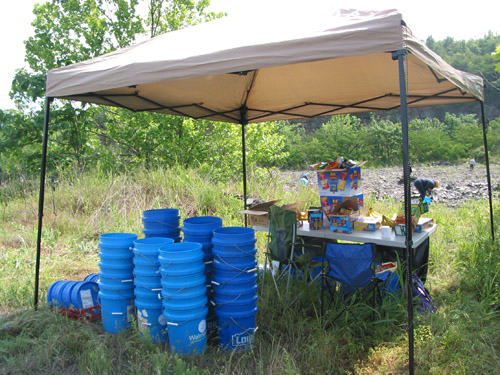
The hospitality area was nice and shady thanks to Casey Sosebee's handy tent
Photo by Lori Carter

Jim Haege and Marzi helped purchase snacks and set up the hospitality tent
Photo by Lori Carter

Everyone who wanted one went home with a nice blue bucket!
Photo by Lori Carter

Field notebooks with matching pens were an extra little gift for everyone
Photo by Lori Carter

Field trip chair Charles Carter (center) scans the collecting site
Photo by Lori Carter

The site had rows of ridges for easy collecting
Photo by Lori Carter
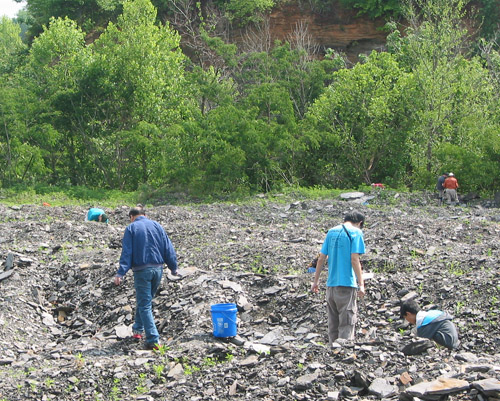
The shale was already broken and there was plenty to peruse
Photo by Lori Carter
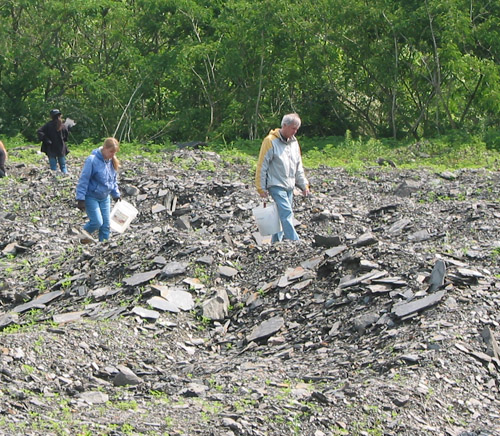
Linda and Tom Batcha looking for fossils
Photo by Lori Carter

The collecting area was large so everyone spread out
Photo by Lori Carter

You can see the ridges in this picture
Photo by Lori Carter

No lack of shale here
Photo by Lori Carter

A specimen showing fine mud ripples and cracks?
Photo by Lori Carter

Close up of the picture above
These are probably burrows
Photo by Lori Carter

Some nice seed fern leaves
Photo by Lori Carter

Close up of the seed fern leaf above
Photo by Lori Carter

Trilobite traces in sandstone (highlighted area in close up below)
Photo by Lori Carter

Close up of the trilobite traces above (enhanced for contrast)
Photo by Lori Carter

Maybe a shell, maybe a trilobite?
Photo by Lori Carter

Some tiny tracks
Photo by Lori Carter

Blurry close up of the tracks above
Photo by Lori Carter

Gail Leddingham found a cute "duck"
Photo by Lori Carter

Gail also found some nice trilobite traces (highlighted area in close up below)
Photo by Lori Carter

Close up of Gail's trilobite traces
Photo by Lori Carter
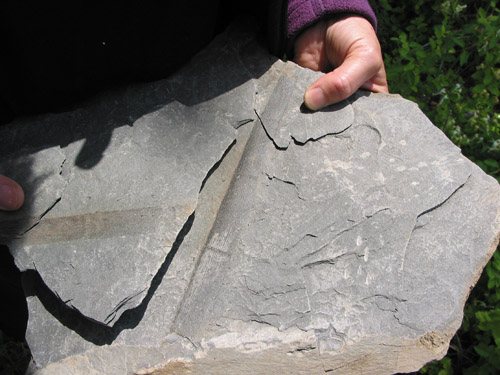
Cordaites?
Photo by Lori Carter

Close up of the fossils above
Photo by Lori Carter

Lycopod roots
Photo by Lori Carter

Close up of the roots above
Photo by Lori Carter

George Prince found a sandstone chunk full of trilobite traces (highlighted area in close up below)
Photo by Lori Carter

Close up of the trilobite traces above
Photo by Lori Carter

More traces from the chunk of sandstone (highlighted area in close up below)
Photo by Lori Carter
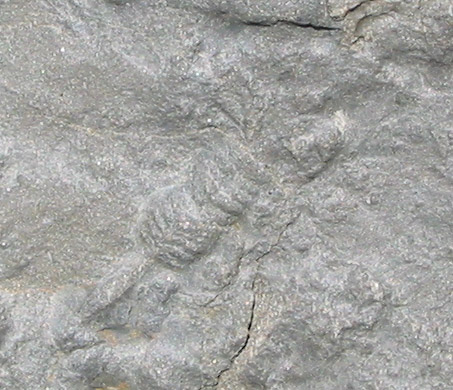
Close up of the trilobite traces above
Photo by Lori Carter

Another section of the sandstone chunk with trilobite traces (highlighted area in close up below)
Photo by Lori Carter

Close up of the trilobite traces above
Photo by Lori Carter

One more view of the sandstone chunk with trilobite traces (highlighted area in close up below)
Photo by Lori Carter

Close up of the trilobite traces above
Photo by Lori Carter

A nice example of the Pennsylvanian plant fossils found here
Photo by Lori Carter

This gentleman found an Attenosaurus subulensis track right by the cars!
Photo by Lori Carter

Close up of the Attenosaurus track above
Photo by Lori Carter

Monica Scheller found this unusual lycopod specimen
Photo by Lori Carter

A closer look at Monica's lycopod. Note the fine scars (tiny lines)
Photo by Lori Carter

A close up of Monica's lycopd. Note the faint impression of a leaf just left of the center.
Photo by Lori Carter

Another view of Monica's lycopod. The leaf impression is in the upper left of this image.
Photo by Lori Carter

This is part of the lycopod Monica found.
Photo by Lori Carter

Close up of the picture above
Photo by Lori Carter

Another view of Monica's find
This specimen was donated to the McWane Science Center in Birmingham, AL
Photo by Lori Carter

Kevin Phillips found this beautiful plant fossil (close up below)
Photo by Lori Carter

Close up of the plant fossil above
Photo by Lori Carter

A fantastic fish swimming trace Undichna
Photo by Lori Carter

Close up of the fish swimming trace above
Photo by Lori Carter

Swamp gas eruptions
Photo by Lori Carter

Opposite side of gas bubbles above
Photo by Lori Carter

Arborichnus repetitus -- possibly the resting trace of a 10 legged crustacean
One of the APS members gave us this specimen
Photo by Lori Carter

Stiaria invertebrate trackway made in flowing water
(Tracks run across the top of the image)
Photo by Lori Carter

Close up of Stiaria tracks above
These tracks may have been made by a hopping insect
Photo by Lori Carter

More details of Stiaria tracks above
Photo by Lori Carter
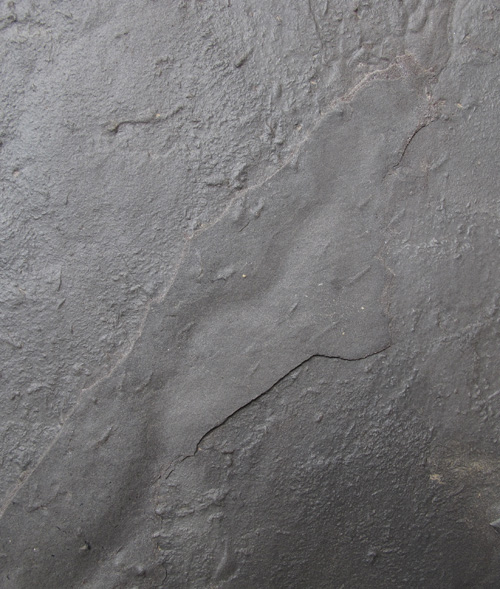
Another view of Stiaria tracks above
Photo by Lori Carter

Shell impression
Photo by Lori Carter
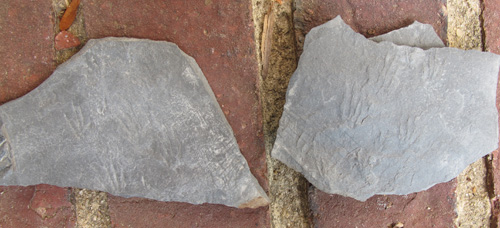
Cincosaurus cobbi tracks
One of the APS members gave us this specimen
Photo by Lori Carter
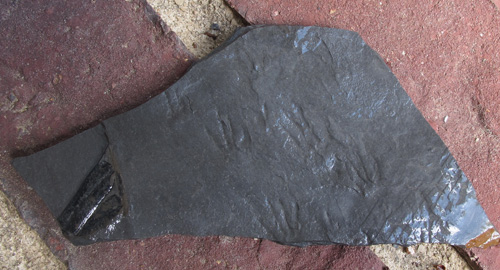
Cincosaurus cobbi tracks (surface or undertracks?)
Note the leaf fossil in the lower left
Photo by Lori Carter

Cincosaurus cobbi tracks (surface or undertracks?)
Photo by Lori Carter

Trilobite traces (highlighted area in close up below)
Photo by Lori Carter

Close up of trilobite traces above
Photo by Lori Carter

Not sure what these are
Photo by Lori Carter

Opposite of the picture above?
Photo by Lori Carter

Fish swimming trace
Photo by Lori Carter

More Cincosaurus cobbi tracks
Photo by Lori Carter

Close up of Cincosaurus cobbi tracks
Photo by Lori Carter

Fern fossils. Note the large gas bubbles. (highlighted area in close up below)
Photo by Lori Carter

Close up of fern fossils above
Click below for field trip policies

Copyright © Georgia Mineral Society, Inc.
